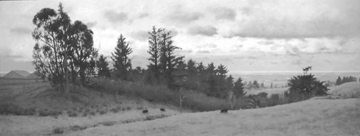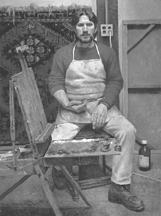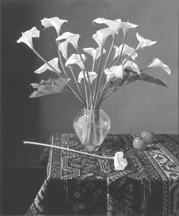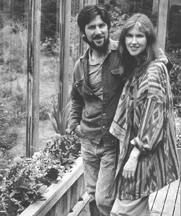

by George Ringwald

"I was just reading," said artist Terry Oats, "that Whistler was the most painted artist. I think Jim is, too."
She was speaking of her husband, Jim McVicker, who has been the subject of at least a dozen portraits by fellow painters in Humboldt County, not to mention his own self-portraits. McVicker may be as well one of the most photographed and written-about artists of his time.
American Artist, one of the nation's major art magazines, did a special feature on him in December 1989. Also in that year, McVicker won second place in the portrait competition by another painters' magazine, Artists, and then won first place in the same competition by that magazine the next two years running.

Self Portrait, oil on linen, 1993
"It was a shock to me," McVicker said in a recent interview. "Surprising enough to win it the first time, but to get it a second time in a row ... After that they started a policy that an artist who won an award could not be eligible for that award for two or three years after that."
"You can spot a McVicker 10 miles away," declared Greg Rumney, partner in Chromogenics, a Fortuna photo lab that in the past has handled the picture-taking of McVicker paintings.
"It's just his style; it's very invigorating. ... It's like Christmas time for me every time he comes in (with paintings to be photographed)."
Bill Thorington, a local banker, and his wife, Linn, a paralegal, are longtime art collectors, and have eight or nine McVickers.
"We moved up here (from Sacramento) in the mid-'70s," Thorington related, "and we sought out the better artists, and his paintings just stood out. Jim is one of those painters -- if it's a landscape, you can relate to having been there. ... His style -- it doesn't look like he's painting, it looks like this unbelievable work. It looks effortless for him, but of course it isn't.
"He's really a local treasure. He's got such a national reputation."
The irony is that probably few people in Humboldt County are aware of that reputation, because so little of his work is shown -- or sold -- locally. His work has appeared in such disparate environs as Rock Springs, Wyo.; Sacramento, Palm Springs, at Gumps in San Francisco, and at the Foxhall Gallery in Washington, D.C.

Calla Lilies, oil on linen, 1990
McVicker still lifes are reputed to be virtuoso works, but you're not likely to see one in this neck of the woods. Most of them are done on commission for collectors outside the area.
"He sells them before they're even finished," noted Sharon Arnot. "That's how good he is."
Arnot, herself a painter, and husband Jim, president of Humboldt Land Title Co., have three McVickers of their own and one Terry Oats -- a lovely small floral piece -- among the dozens of paintings that fight for wall space in their Freshwater home.
Rumor has it that one of Jim McVicker's self-portraits hangs today in the Smithsonian, but McVicker says he doesn't know that for a fact.
He does know that the painting did wind up in the possession of a noted Washington, D.C., collector, James Goode (he has a collection of artist self-portraits that "might be up in the hundreds," McVicker speculates), and that McVicker's was going to be Goode's last purchase.
"Well, he is donating part of that collection to the Smithsonian National Portrait Gallery," said McVicker. "I have no idea if mine will end up in the Smithsonian Institution or not, but it would be nice if it did."
That concluding comment -- if I'd needed any other evidence of what I'd already deduced from two interviews with Jim and one with wife Terry, plus what I'd heard from practically every McVicker fan -- summed up the self-effacing character of both McVickers.
It's like a litany.
"He's so unpretentious about his work, and very humble," said Bill Thorington. "He's always pushing other artists. ... Whenever we see him, he's saying, 'Have you seen so-and-so's work?'"
Jim and Terry "are like the cheerleaders of the art world," observed another area art enthusiast. "They're very supportive of other artists." This woman remembered in particular the great encouragement the McVickers gave to a budding artist on the North Coast scene, Linda Mitchell.
"'Oh, you're getting better,' they'd tell her. And it's genuine! Not fakey ... The thing that's neat about them is that they're not arrogant."
Mitchell herself recalled, "I had this disastrous opening, and Jim told me about one of his that was a disaster, and it just helped me a lot."
"There's not an egotistical thought in his head!" Sharon Arnot said of Jim.
"I think that's definitely true," agreed Michael Hackett, partner with Tracy Freedman in the Hackett-Freedman Gallery of San Francisco, where McVicker now shows his paintings. "He's very self-deprecating."
That's not necessarily rare among artists, but it could be that Jim McVicker has a special niche in his memory of where he came from.
McVicker, who turned 45 in November, grew up in Ontario, Calif., where his parents still live, and didn't develop an interest in art until he was out of high school and had gone to nearby Chaffey Community College for about a year. He dropped out, did some traveling -- after the usual fashion of a young man coming of age -- and worked at assorted jobs: house painting, handyman and gardener, carpenter's helper in the old Kaiser Steel mill in Fontana.
It was "through a girlfriend at the time, who was and still is an artist," McVicker recalls, that he got into painting. He went back to Chaffey for night classes in drawing and painting, and in 1975 gave up his job at Kaiser to go up to Santa Cruz (where a friend had a spare room for him) and jump fulltime into painting.
"Everybody told me I was crazy," McVicker said. "They were saying, 'Oh, you'll be back at Kaiser. ... Everyone comes back.' " His response was two words: No way.
Painting, he says now, "became a passion for me almost immediately, so I felt I had to get away from all those influences that weren't so supportive of artists. ... I was more interested in nature and painting outdoors, and I wanted to go to an area that for me held more beauty and less cement that Los Angeles did, and was less crowded and more affordable."
It turned out that Santa Cruz wasn't what he wanted either -- not after being exposed to Eureka. He'd come up to the North Coast to visit the former girlfriend, Roberta "Missy" Vivenzio.
"We had remained friends, and we're still friends to this very day," McVicker said. "She had moved up to Eureka with her boyfriend, and I came up to visit a couple of time, and liked the area a lot. ... It had more of a working-class attitude up here. Santa Cruz seemed more touristy, beach-oriented, and so forth."
The move to Humboldt County and especially his meeting here with George Van Hook were, as McVicker remembers it now, his breakthrough. McVicker and Van Hook, two pockets-empty painters, became inseparable painting buddies for about three years.
The Times-Standard in February 1980 did a photo feature of the two of them doing street painting in Old Town. They worked together, the story said, "for moral support and companionship and as a way to save gasoline." Van Hook was quoted: "It's nice to know there is a comrade being as foolish as you are."
"We often went out in George's little truck," McVicker recalls. "We'd leave at sunrise and come back at dark ... just painted all day long, just as I do now, but back then we were hardly making a dime. Our expenses were a lot less. I lived in a coldwater flat, you know, no shower, just a toilet, and paid 50 bucks a month for it."
He laughed lightly and added: "But we were immensely happy going out painting together all the time, and it was an enormous growing phase for me."
(Van Hook has since moved to New York, where Jim and Terry most recently visited him in September.)
McVicker, craggily handsome, with longish unruly dark brown hair, is still a lean trim figure of a man, but in the Times-Standard photo of 1980 he looks almost a stick figure. McVicker smiled and said, "I have filled out. I think I probably weighed about 128 then, and think I weigh about 150 now."
"They were just like babes in the woods," said their longtime friend, benefactor and collector, a woman who likes to go by just her first name, Skye. The two of them would come up to her home in Bayside and work in her garden.
"George came up and brought his lunch one day," she said, "and he had one chopstick." When she asked how he expected to eat with just one chopstick, Van Hook told her, "Well, I can use a pencil."
Skye has a dozen or so early works of both Van Hook and McVicker. The early McVickers -- a boxcar on a railroad siding in Arcata, a Eureka street scene, a cloudy blast of smoke from a Scotia lumber mill -- are, not surprisingly, in sharp contrast to his work today, in subject matter as well as in style. They seem stark and blunt compared with the subtle delicacy of, say, one of his present-day Loleta countryside paintings.
(Loleta, where Jim and Terry have their home now -- assuredly with hot running water, showers, the whole works -- is Jim's favorite working environment. He and Terry both paint in their garden at times. Lately, Terry has been concentrating on the redwoods.)
Skye, who has been a teacher and artist and at one point in her life even ran a sandals shop in Carmel, described Van Hook and McVicker as "the nucleus" of Humboldt County's embryonic art community in the 1970s.
"Prior to George and Jim," she said, "there was a lot of bickering in the art community. They helped pull it together. ... They were out there working hard, almost a psychotic drive, not sitting around bitching."
It was in the garden of Skye's home that Jim and Terry, who had met through a mutual friend, were married in 1988 -- "about a year before Jim's career really got going," as Terry put it.

Jim McVicker and his wife, Terry Oats, relax in the garden of their Loleta home in 1993. Photo by Naomi Young-Brisco
The two of them form their own mutual admiration society.
Jim, a jazz aficionado, said he'd bought himself a saxophone on his 40th birthday, and he's been trying to learn it for the past five years.
"Terry," he said, "is just an amazing spouse -- being with me for five years trying to play the saxophone!"
When I later tell Terry of Jim's praise, she responds: "He's great! It's wonderful being married to another artist -- they're so understanding." She paused, then quickly added, "Well, maybe I shouldn't say any artist."
Terry indicated she could hardly remember when she wasn't drawing and painting, and kept at it despite many a discouraging word -- from "teachers, counselors, everybody." Except for a very supportive mother. "She brags shamelessly," said Terry. "About Jim, too."
Terry left her native New York for California in 1982.
"I'd heard that it was extraordinarily beautiful, and with strong art communities," she said.
Before making painting her fulltime pursuit, she worked locally as a graphic artist. A most private person, Terry is reluctant to say more about that.
(There is a touching shyness about Terry. She said, "I find it so revealing just having your painting out there.")
She explained: "I leave all that behind. The more I talk about what I'm doing now, the more that kind of thing happens."
Oats does mainly figure work. "Figures are dramatic," she said, "because people are dramatic." One of those dramatic figures was that of a stunning lady in red, an Oats portrait that was part of a show in October at the Humboldt Arts Council Gallery in Eureka.
"I thought that was an excellent painting," said Joan Dunning, a fellow artist and writer, and close friend of Terry's. "I think some of her paintings Are absolutely the best paintings that are being done in the county. ... When she is on, she is so on. ... There's no one more poignant."
(Dunning also provides a delightful vignette on the McVicker-Oats relationship. "I remember once being at the playhouse in Ferndale," she related, "and seeing Terry stand up after the play was over and hearing her thanking Jim so touchingly for bringing them to the theater. I think they have a dear relationship with each other ... quite a formally courteous relationship. I think they absolutely adore each other.")
Terry credits Jim for much of what she's learned about art.
"He's been a mentor," she said. "I learned that an artist works seven days a week. And I never knew how you catch light. ... At sunrise and sunset, you only get about 15-20 minutes of light."
Painting is their addiction, their obsession, call it what you will -- as it is with the world's masters.
"Sometimes," said Terry, "we think of taking a day off, and then we both decide that what we really wanted to do was paint."
And it was Jim, Terry said, who helped her achieve "a mental attitude change in myself -- that I could sell my work. There are so many myths -- that art only sells after you die."
She doesn't put herself in the same money-making league with Jim. She might be able to support herself today by painting -- "but I'm sure I couldn't have the lifestyle we have now."
The two have their studios on the second floor of a big old building in Eureka's Old Town that has become a kind of artists' row. A dozen have their studios there now.
"There's a wonderful community of artists up there," said Rusty Krause, owner of the building. "They give each other ideas. They've created a real sense of neighborhood."
"We're all real happy to see somebody sell a piece, happy to see somebody get an award," McVicker said of this little art community. "You know, we feel for somebody if they're having a problem with a gallery or having a problem with painting."
The Humboldt Arts Council exhibit last fall at which Terry's "Maren in Red" painting was shown was one of the rare local showings for McVicker. In fact, the show was called "McVicker and Friends," and for many of them it was a kind of reunion from a showing three years earlier with the Arts Council.
Desiree MorganReyes, program director of the Humboldt Arts Council Gallery, said that most of the 17 painters represented in the exhibit show and sell mainly outside the area.
"Their work is in demand, all across the country ... and it's selling very well."
McVicker offers a fuller explanation.
"It's really the only way to make a living," he said. "It's survival. Any artist locally who's painting and living here and wants to try to survive on the sales of their artwork, it's inevitable that you have to go outside the area -- to a bigger city, where there's more money, more galleries, more interest really. ...
"Humboldt County is a notoriously depressed county and always has been, although I have sold a number of paintings locally, as other artists have. ... There are some fabulous collectors locally ... (but) it's never really been enough to feel I could rely on local sales. Because you sort of deplete the people who will buy your work in not too much time."
For McVicker, the boost into the big time came with the opening of the Michael Atlee gallery toward the end of the 1980s.
Atlee, as McVicker remembers, "just did amazingly well for a couple of years locally with my work, as well as selling to some people out of the area.
"I was pretty shocked by it, actually," he went on. "I'd been showing here for a long time, and sold, but never enough to feel like there were that many people locally interested in buying art work. So it was that experience that really gave me a lot more confidence, in feeling that I'd be able to sell my work in The City (meaning of course San Francisco). I'd been showing in San Francisco, at Gumps, and showing back East ... but it was always just a struggle."
The breakthrough with Mike Atlee was, as McVicker put it: "Wow! This is really great! And I really realized that I could make a middle-class living."
Artist Joan Dunning, who today lives in the same Arcata house that Atlee did, shares McVicker's enthusiasm about the brief Atlee gallery era. When I asked what was so special about the man, she replied: "He's so intelligent, warm and personable, and he has such a great taste in art ... He really generated a lot of community activity." Yhen after only a few years he closed shop here and moved to Southern California -- "because he wanted to be closer to his family," as Dunning recalls -- it was upsetting to the local art community.
Said Dunning: "I don't think that he realized what he meant to people ... how central he was to the whole dynamic here."
Three years ago, on the heels of the "Wow!" experience with the Atlee Gallery, McVicker opened his present relationship with the Hackett-Freedman Gallery in San Francisco.
"They have done very, very well with my work," McVicker said. "When an artist is trying to make a living at their art -- when they don't have spouses to support them or a trust fund or any number of things that artists in history have had -- then you really do need an excellent gallery or dealer ... to get behind your work."
Michael Hackett remembers how he was introduced to McVicker's work: "Jim sent me slides; I looked at them and was very interested ...
"Of the California landscape painters we represent," Hackett added, "his work I would consider the most committed to early California. His paintings have a distinct sense of place. ... He's also a very accomplished portraitist."
McVicker has always painted in oil, which reminded me of a story I'd been told by the late Viola Russ McBride, a talented water colorist. She said she'd started in oil, but when she was painting outdoors the bugs kept getting stuck in it, so she switched.
"That's true," said Jim, smiling at the story, "and you can find a few bugs in my oil paintings of the outdoors. You paint right over them ... I really love oil paints, the way you can manipulate them and the way you can work things over ... And I like the look of the oil paintings, the rich color, the textural qualities ..."
In the American Artist article on McVicker, I read that he tries to find an outdoor setting where he can work on five or six different paintings throughout the day, "switching canvases as the light changes."
As it happened, he had been doing just that the day before, and he had the canvases in his studio when we met there.
"It's been a way of working on the landscape that I feel very natural with," he said.
(He didn't feel all that at ease with it in the beginning, though. In fact, he "was shy about it." He explained: "Going outdoors, I was afraid; it's very intimidating going out somewhere where the public is going to see you working. So I was doing (landscape) paintings looking out my window.")
Two of the river scenes on the canvases in his studio then were painted at different times in the morning. Another, with breath-taking golden tones, was done at sunset.
"What I'm going for in my painting is the light," McVicker said, "and that particular time of day. I basically paint what I see and feel. I feel like they're all part of one book, so to speak, but at different times of day."
McVicker may quite aptly be described as a luminist.
"I like that term," McVicker said. "I'd never heard that term applied to my work, but I think it's really true, because my work is more realistic than, like impressionist painting ... And the light and the atmosphere are what I'm after. There was a movement in the 19th century called the Luminist Painters, and their paintings are very much about the light and mood. ... You see a lot of paintings in that school of sunset-sunrise, very atmospheric, light-filled paintings."
One of the latest light-filled paintings that he'd brought indoors to the studio was especially large, I noted, 44 inches by 90 inches, and even carting them around in a van, as he does, I'm thinking, whoa, that's a bit much!
Jim smiled his agreement. "In fact," he said, "there's a lot of painters who paint outdoors that look at that, and go, 'My God! You took that outside?' It is cumbersome, and this is such a fleeting lighting effect ... I'll do a lot of indoor work on it, too."
Sunrise, sunset. "I find those times of day very exciting," McVicker told me. "Just quiet light and subtle variations of tone."
He usually gets moving by 6 or 6:30 in the morning to catch that first light.
"And all year long, if the weather's nice, I'll paint until dark, until after the sunset. You know, in the summertime I'm out there still at 9:30. (He does take a mid-day break of an hour or two.)

Jim McVicker and Homer painting at Fernbridge. Photo by Greg Rumney
Steve Porter, one of Jim's artist friends, related this story: "Once he was out painting, and all of a sudden he noticed he was shaking with the cold. It was almost like hypothermia. Painting is something that just takes over."
I am reminded of Skye's words -- this "almost psychotic drive." McVicker wouldn't think so.
He put it like this: "It's not so much, 'I gotta work. I gotta work.' It's an exciting thing to do. It's hard work ... but it's very rewarding. Some days are incredibly frustrating; other days are exhilarating ... But I couldn't think of anything else to do with my days.
"And, you know, I looked around and saw a lot of people that I thought had a lot more talent than me, and so that was a push that I just had to work harder ... And I still don't feel I've arrived where I want to go ... I still feel there's a lot of growth and possibly change in my work over the years."
And he doesn't forget the kind of business he's in.
"It took me, I think, literally 15 years of trying to market my work outside this area before it really started taking off," he said, as if in a reminder to himself. "And, you know, I always knock on wood, because anything could change at any time in such a fickle business."
George Ringwald is a free-lance writer in Eureka with a former life as investigative reporter for the Press-Enterprise in Riverside and Tokyo bureau chief for Business Week magazine.